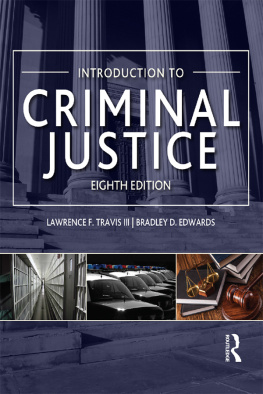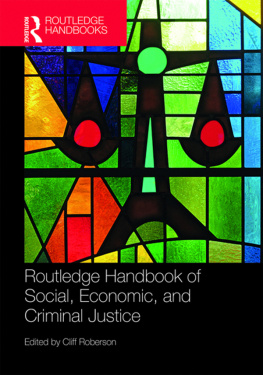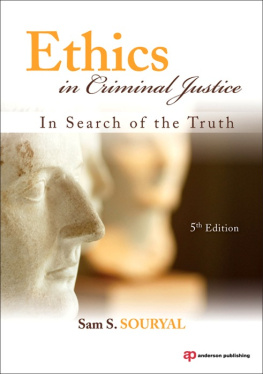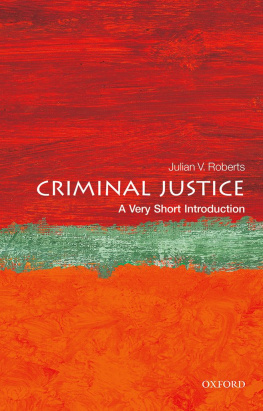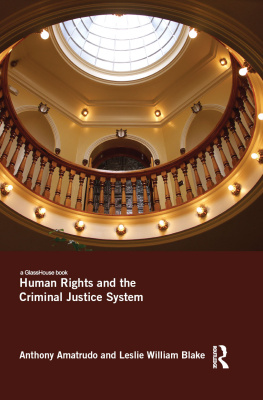Introduction to
Criminal Justice
EIGHTH EDITION
Introduction to
Criminal Justice
EIGHTH EDITION
Lawrence F. Travis III
University of Cincinnati
Bradley D. Edwards
East Tennessee State University

First published 2015 by Anderson Publishing
Published 2015 by Routledge
2 Park Square, Milton Park, Abingdon, Oxon OX14 4RN
and by Routledge
711 Third Avenue, New York, NY 10017, USA
Routledge is an imprint of the Taylor & Francis Group, an informa business
Acquiring Editor: Pamela Chester
Development Editor: Ellen S. Boyne
Project Manager: Punithavathy Govindaradjane
Designer: Russell Purdy
Copyright 2015, 2012 Taylor & Francis. All rights reserved.
Copyright 1990, 1995, 1998, 2001, 2005, 2008
No part of this book may be reprinted or reproduced or utilised in any form or by any electronic, mechanical, or other means, now known or hereafter invented, including photocopying and recording, or in any information storage or retrieval system, without permission in writing from the publishers.
Notices
No responsibility is assumed by the publisher for any injury and/or damage to persons or property as a matter of products liability, negligence or otherwise, or from any use of operation of any methods, products, instructions or ideas contained in the material herein.
Practitioners and researchers must always rely on their own experience and knowledge in evaluating and using any information, methods, compounds, or experiments described herein. In using such information or methods they should be mindful of their own safety and the safety of others, including parties for whom they have a professional responsibility.
Product or corporate names may be trademarks or registered trademarks, and are used only for identification and explanation without intent to infringe.
This book and the individual contributions contained in it are protected under copyright by the Publisher (other than as may be noted herein).
Library of Congress Cataloging-in-Publication Data
Travis, Lawrence F.
Introduction to criminal justice / Lawrence F. Travis III and Bradley D. Edwards. Eighth edition.
pages cm
ISBN 978-0-323-29071-5
1. Criminal justice, Administration of-United States. I. Edwards, Bradley D. II. Title.
HV9950.T7 2014
364.973dc23
2014014251
British Library Cataloguing in Publication Data
A catalogue record for this book is available from the British Library
ISBN 978-0-323-29071-5 (pbk)
Contents
This eighth edition maintains the same approach to criminal justice that characterized previous editions. The central purpose of this text is to provide students with a relatively brief, affordable, and comprehensive overview of the criminal justice system. As in earlier editions, the style and vocabulary are set at the reading level of the typical college freshman. I hope that reading this book is informative as well as exciting and entertaining for students.
Many introductory students do not realize that criminal justice is a science, with an ever increasing knowledge of the important topics covered in this text. As with previous editions, the most widespread changes in this edition of the text involve updating the references to reflect the most current knowledge available. There is increased discussion throughout the book of important topics such as terrorism and problem-oriented policing, which have become more prevalent over the past several years. , in particular, received a significant restructuring to include sections on criminal justice careers and a brief introduction to the academic side of criminal justice. Finally, this edition includes an increased number of graphs and transitions from a two-color to a four-color format to increase the visual appeal of the book. My hope is that these changes allow for a more pleasurable reading experience.
Those who have used previous editions will notice the addition of a new author. In fact, Lawrence Travis III did not participate in this edition of the book. I am grateful to Lawrence for creating the foundation for this book and its many successful editions. His mark will certainly be felt in this edition and any subsequent edition. I must also thank Steve Lab and John Whitehead, the authors of on the juvenile justice system.
I am grateful to Michael Braswell for his support in general and on this book. I am also thankful to have worked with a wonderful staff at Elsevier, especially Ellen Boyne, the project editor. Her professionalism and dedication is unsurpassed. I also owe a thank-you to Kirsten Piatak for her help with the ancillary material. Finally, this edition would not have been completed without the love, support, and patience of my wife, Nyela. Thanks to you all.
Bradley D. Edwards
Important Terms
criminology
education
evidence-based policy
training
Imagine that you are standing on a busy street corner. You look at the people around you. What do you see?
A woman drops a postcard in a mailbox.
Across the street, a man carrying a small suitcase steps off a bus.
Several feet away from you, a couple is arguing about something.
A police car slowly passes through the intersection.
Less than half a block away, someone is jaywalking while a small child nearby reads a street sign.
A man deposits money in a nearby parking meter.
A stranger approaches and asks that you sign a petition in support of banning cell phone use by drivers.
What you probably do not see is that the mix of pedestrian and vehicular traffic is orderly. You do not notice that almost everyone watches the police car, at least briefly. You do not realize that all of these strangers at the intersection are going about their own business, apparently unaware of each other. Yet, in a well-rehearsed routine, they stop and go on cue from the traffic light. You probably do not see a crime (with the possible exception of the jaywalker).
Without realizing it, you have observed the criminal justice system in action. What you did not know is that the postcard was a monthly report the woman was sending to her probation officer. Nor was it clear that the man with the suitcase just left the state penitentiary on parole. The arguing couple may be tonights domestic disturbance (or last nights). The slow-moving police car is searching for the small child, who is reading the street signs because he is lost. The jaywalker crossed the street to avoid walking past a group of teens gathered on the sidewalk. The man at the parking meter wants to avoid a citation. The person with the petition hopes to ensure that motorists refrain from using cell phones by making it criminal to do so.
The workings of the criminal justice system affected the entire street corner scene just described, and all of the individuals in it. Interestingly, the individuals also directly affect the workings of that system. Should the argumentative couple become too boisterous, the shopper fail to deposit the correct coins in the parking meter, the woman not mail the postcard, and so on, you would expect some sort of official response from the justice system. Criminal justice is an integral part of our society and social living.
Sociologists often speak of the purposes of social institutions as functions (Parsons, 1966). are the unstated or hidden goals. Schools serve the manifest function of education through teaching students various academic subjects. They also meet the latent functions of providing child care and controlling the workforce by otherwise occupying millions of young people.
Next page
